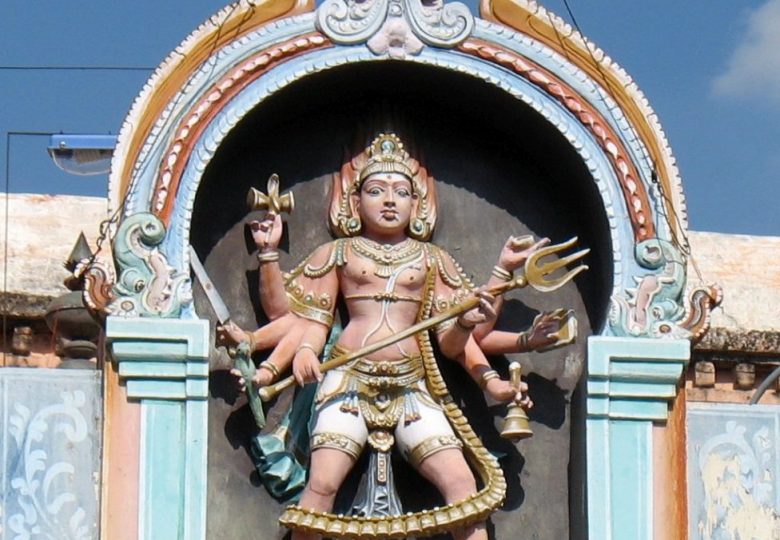Rose and Sandal-Scented Holy Bath to Kalabhairava

Divine 911 Call
You can call upon or pray to a few gods for emergencies like you dial 911 in the USA my guru HH Paramahamsa Nithyananda told. One is Lord Venkateshwara in Tirupati. I had already experienced his manifestation power in Phoenix. Another one is Sundareshwara, a form of Lord Shiva in Madurai. And the third one is Kalabhairava, another form of Lord Shiva.
Kalabhairava – the Lord of Time
Kalabhairava is a terrible, frightful form of Shiva, the Lord of Time, and keeper of the akashic records which some enlightened masters are able to access and read. He likes to make his appearance known with uproarious laughter, carries flames coming out from behind his head, and wears a long necklace of skull heads that reaches down to his knees along with a belt around his waste that carries bells. In some images Kalabhairava is shown depicted with his left foot forward. The black granite image is surrounded by three rings of stylized lotus flowers. Another image shows Kalabhairava with his vahana or vehicle, a black dog. In Kathmandu, Nepal, are yet other images of Kalabhairava.
Kalabhairava, the Lord of Time, takes care of all the people who do wrong to others. All misdeeds eventually come to justice. That is how the universe works.
He is also known as Kshetrapalaka, guardian of Shiva Temples and Shakti Peethas. It is tradition to symbolically submit the temple keys to Kalabhairava upon closing time of the temple and to receive them back when the temple reopens the next morning.
One of the most favorable times to worship Lord Kalabhairava is on Asthami, the eighth day after Purnima or full moon.
Step-by-Step Abishekam or Holy Bath to Kalabhairava
One day I decided to have a Kalabhairava Abishekam holy bath done at the Arunachaleshwara Temple. I hired a local guide who set everything up for me. I only needed to show up. On the chosen day my guide picked me up on his motorcycle and we went to the temple going to the Kalabhairava Shrine.
The priest came and unlocked the gated shrine. Sitting close to the deity just outside the sanctum is special. My kundalini immediately was happy seeing Kalabhairava and I started making involuntary movements with my head and shoulders showing a blissful smile and my mind reducing its number of thoughts.
The priest undressed the deity getting it ready for the holy bath of abishekam. He then placed my small Kalabhairava image at the feet of this more than life-size deity.
- First the deity was cleaned with water and massaged with gingelly or sesame oil. The oil was rinsed with rose water.
- Next followed the pouring of milk and broken rice powder that was mixed with water. All then was cleaned off with water.
- Viboothi or holy ash was applied to the head of the deity and other parts of its body. After removal of the viboothi which was kept aside, another rinse with water happened.
- Turmeric was mixed with water and poured over Kalabhairava followed by another water shower.
- Three small bananas were crushed with jaggery sugar and applied to the top of the head and all over the body, and then cleaned with water.
- The last liquid poured was a mix of sandalwood and rose water mixed together in water. It must have smelled just heavenly.
One could imagine how kings in ancient times bathed in sandalwood and rose enriched water.
- Kalabhairava then was dressed with an artfully folded sari that appeared to look like a dhoti.
- A kummerbund was added and another sari folded for the top portion of the Vedic outfit.
- Next Kalabhairava received a number of sandalwood paste dots on his spiritual eye, his eight hands and weapons, his feet, which received a mark of red kumkum on top of it.
- The priest also added sandalwood paste dots along the deity’s neckline.
- Last the deity was garlanded with three flower malas, necklaces.
The next part of the ritual was camphor aarati, waving of light, when the priest asked the sponsor, me, for name, nakshatra, rashi and lineage, and the names of family members who should receive the blessings also. I gave my information and the names of my son and my guru, the two most important beings in my life.
- Here the priest and a devotee were chanting mantras, sacred syllables.
- This was followed by offering food to the deity and aarati, the showing of light.
- The priest then gave me prasadam, offered items like a pot full of turmeric rice, coconuts which were cracked earlier, a bag filled with viboothi powder, ashes that were used during abishekam and retrieved from the head of the deity, bananas, pan or betel leaves with areca nuts, and two of the offered flower garlands.
I felt richly blessed to receive these items. I truly was not expecting anything. That is the beauty and joy when one does not expect anything and then is showered. And the priest returned my small image of Kalabhairava which had also received abishekam at the feet of the large Kalabhairava image. Sitting for an hour at the energized large image the small one now was energized as well. Then the priest locked the shrine doors and left.
Only now I noticed that about 40 or so devotees had gathered behind me watching the abishekam. They were now all eager to receive prasadam, a handful of blessed turmeric rice that I handed out. Before leaving the shrine I went to offer my final pranams to Kalabhairava, and it looked like he had a big smile in his face being pleased with the abishekam and offerings. That smile was thrilling! You may think how can a granite stone image suddenly smile. Over the years I have heard many stories and experienced myself amazing expressions of the divine energy in those images and working through them. It is possible. An energized deity is a living entity that responds to the energy of the devotees.
When I left the shrine with my guide we went to a more quiet area of the temple near the Pei Gopuram temple tower on the western side of the temple, to have some prasadam ourselves and arrange things for the return trip. Two hungry and very shy dogs came slowly closer and partook in the prasadam as well. Still there was rice left. I then visited friends who received rice prasadam and other items from my goody bag. Still much left in the bag I went to the main road near an ashram and gave bananas and pan leaves away. Sharing the prasadam with many makes it a celebration. What a blessed morning!
- Name: Kalabhairava Shrine at Arunachaleshwarar Shiva Temple
- Town: Tiruvannamalai, Tamil Nadu
- Special: Town is birthplace of HH Paramahamsa Nithyananda
- Directions: SW of Chennai, 3.5 hours by taxi
- Event Fee: RS 1,000 for Abishekam paid to the temple
- Donations: RS 200+ to the priest plus a fee for the guide
- Photography: Ok
- Access: Open to Hindus and Non-Hindus
- Spiritual Takeaway: Sharing the prasadam, blessed food, with others is a common practice at the temple and makes it a blissful celebration for all
In the comments below share your experience visiting this temple. Feel free to ask any questions you may have.
Ma Udaysree has lived for six years in South India and is the organizer of Sacred Temple Journeys. She offers small group spiritual temple tours to Tiruvannamalai, Kumbakonam, Madurai, Bidadi, and other places in South India. Udaysree is the author of ‘Living at Arunachala.’

